“Global Warehouse Simulation Market to reach a market value of USD 1.4 Billion by 2031 growing at a CAGR of 14.2%”
The Global Warehouse Simulation Market size is expected to reach $1.4 billion by 2031, rising at a market growth of 14.2% CAGR during the forecast period.
North America’s strong e-commerce ecosystem, led by giants like Amazon and Walmart, has fueled the demand for sophisticated warehousing solutions. The region also has a high automation adoption rate, with many warehouses leveraging technologies like robotics, autonomous mobile robots (AMRs), and conveyor systems to improve efficiency. Consequently, the North American region would acquire nearly 30% of the total market share by 2031.
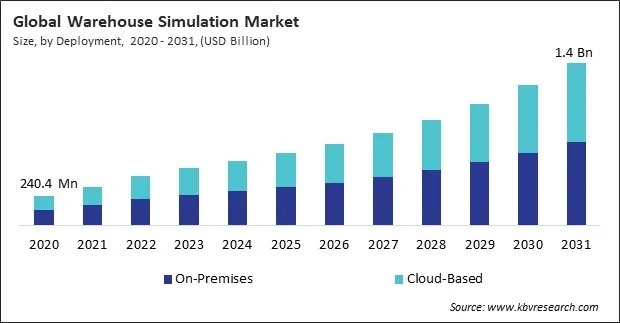
The major strategies followed by the market participants are Product Launches as the key developmental strategy to keep pace with the changing demands of end users. For instance, Two news of any two random companies apart from leaders and key innovators. For instance, In May, 2024, AnyLogic North America, LLC announces the release of AnyLogic 8.9, featuring Git support for version control and a new model format to boost collaboration. These enhancements are designed to improve productivity and teamwork in complex simulations, optimizing efficiency and accuracy in large-scale projects. Moreover, in April, 2024, Manhattan Associates has unveiled the Manhattan Automation Network, designed to enhance warehouse automation and robotics development. This initiative partners with Kindred AI, Locus Robotics, Matthews Automation Solutions, Right Hand Robotics, and VCO Systems, focusing on simplifying integration and lowering costs for distribution centers.
Based on the Analysis presented in the KBV Cardinal matrix; Siemens AG and Oracle Corporation are the forerunners in the Market. Companies such as Rockwell Automation, Inc., Honeywell International, Inc. and SAP SE are some of the key innovators in Market. In March, 2023, Rockwell Automation, Inc. launches FactoryTalk Optix, a modern HMI platform offering cloud-enabled design, testing, and deployment. With its scalability, flexibility, and interoperability, FactoryTalk Optix enhances simulation by improving design productivity, collaboration, and system integration for more efficient operations.
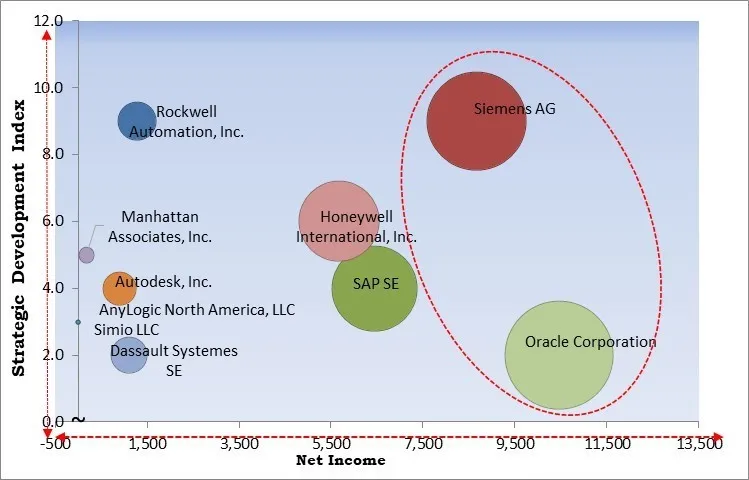
Warehouse simulation software enables businesses to model different layouts, workflows, and processes within their warehouses before implementation. Additionally, these simulation tools are crucial for reducing operational costs. By streamlining workflows, companies can reduce labor costs, minimize unnecessary movements, and optimize space utilization, leading to lower overall expenditures. Hence, the need for faster delivery times, lower operational costs, and optimized inventory management is pushing companies toward adopting this simulation software.
The e-commerce sector has grown extraordinarily, fundamentally transforming the global retail landscape. The rapid expansion of online shopping is increasing order volumes and creating more complex logistical challenges. Thus, the rapid growth of e-commerce is a primary factor driving demand for this simulation technology.
Warehouses, particularly those relying on older infrastructure, face compatibility issues when adopting advanced simulation tools. Integrating new simulation software with legacy systems can also disrupt daily operations, leading to downtime, system crashes, or workflow interruptions. Hence, the complexity of integrating modern simulation software with legacy systems is a significant challenge for the market.
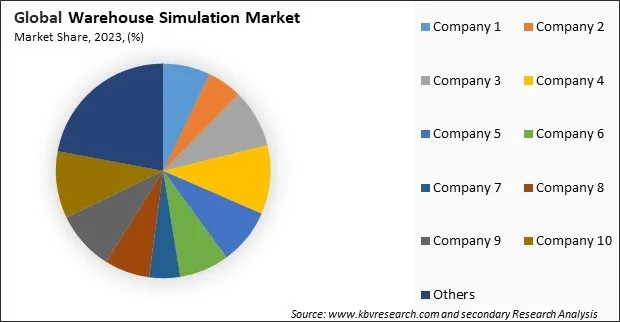
The leading players in the market are competing with diverse innovative offerings to remain competitive in the market. The above illustration shows the percentage of revenue shared by some of the leading companies in the market. The leading players of the market are adopting various strategies in order to cater demand coming from the different industries. The key developmental strategies in the market are Product Launches and Product Expansions.


On the basis of deployment, the market is bifurcated into on-premises and cloud-based. The cloud-based segment recorded 47% revenue share in the market in 2023. Cloud-based simulation solutions offer flexibility, scalability, and ease of access, allowing companies to quickly deploy and manage simulations without requiring extensive IT infrastructure.
By vertical, the market is divided into automotive, consumer electronics, healthcare & pharmaceuticals, food & beverage, retail & e-commerce, logistics & transportation, and others. The consumer electronics segment garnered 21% revenue share in the market in 2023. The consumer electronics industry is distinguished by its high product turnover, rapid technological advancements, and complex supply chains that involve a multitude of suppliers and components.
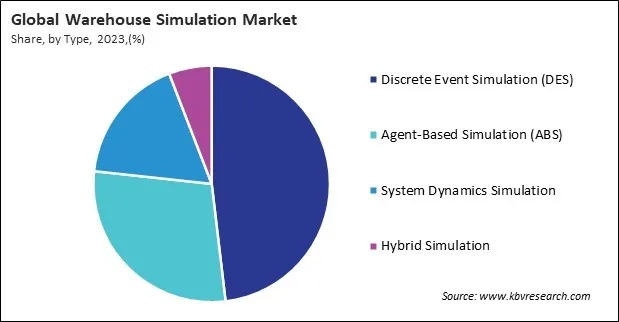
Based on type, the market is classified into discrete event simulation (DES), agent-based simulation (ABS), system dynamics simulation, and hybrid simulation. The agent-based simulation (ABS) segment procured 29% revenue share in the market in 2023. ABS focuses on modeling the behavior of individual agents, such as warehouse workers, robots, or machines, and their interactions with each other.
Free Valuable Insights: Global Warehouse Simulation Market size to reach USD 1.4 Billion by 2031
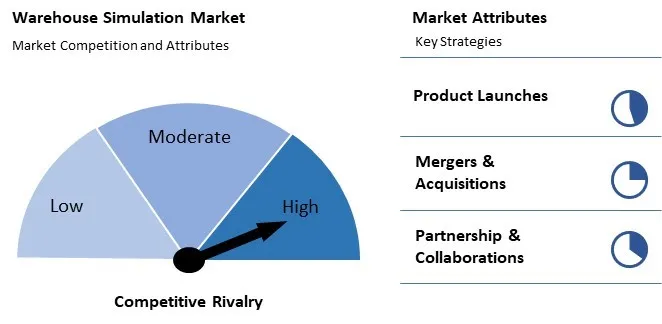
The warehouse simulation market is highly competitive, driven by rising demand for automation and efficiency. Key players include providers of advanced simulation software and solutions that enhance warehouse operations. Innovations in AI, IoT, and digital twins are intensifying competition as companies strive to offer more precise and scalable solutions.
Region-wise, the market is analyzed across North America, Europe, Asia Pacific, and LAMEA. The Asia Pacific segment acquired 39% revenue share in the market in 2023. The rapid growth of e-commerce, the expansion of the manufacturing sector, and the increasing adoption of automation technologies across countries like China, India, and Japan have significantly boosted demand for warehouse optimization tools in the region.
| Report Attribute | Details |
|---|---|
| Market size value in 2023 | USD 477.5 Million |
| Market size forecast in 2031 | USD 1.4 Billion |
| Base Year | 2023 |
| Historical Period | 2020 to 2022 |
| Forecast Period | 2024 to 2031 |
| Revenue Growth Rate | CAGR of 14.2% from 2024 to 2031 |
| Number of Pages | 266 |
| Number of Tables | 393 |
| Report coverage | Market Trends, Revenue Estimation and Forecast, Segmentation Analysis, Regional and Country Breakdown, Competitive Landscape, Market Share Analysis, Porter’s 5 Forces Analysis, Company Profiling, Companies Strategic Developments, SWOT Analysis, Winning Imperatives |
| Segments covered | Deployment, Vertical, Type, Region |
| Country scope |
|
| Companies Included | Simio LLC, AnyLogic North America, LLC (The AnyLogic Company), Rockwell Automation, Inc., Siemens AG, Dassault Systemes SE, Autodesk, Inc., Manhattan Associates, Inc., Honeywell International, Inc., SAP SE and Oracle Corporation |
By Deployment
By Vertical
By Type
By Geography
This Market size is expected to reach $1.4 billion by 2031.
Rising demand for efficient supply chain management are driving the Market in coming years, however, Complexity of integration with legacy systems restraints the growth of the Market.
Simio LLC, AnyLogic North America, LLC (The AnyLogic Company), Rockwell Automation, Inc., Siemens AG, Dassault Systemes SE, Autodesk, Inc., Manhattan Associates, Inc., Honeywell International, Inc., SAP SE and Oracle Corporation
The expected CAGR of this Market is 14.2% from 2024 to 2031.
The Automotive segment led the Market by Vertical in 2023; thereby, achieving a market value of $287.4 million by 2031.
The Asia Pacific region dominated the Market by Region in 2023, and would continue to be a dominant market till 2031; thereby, achieving a market value of $538.4 million by 2031.
Our team of dedicated experts can provide you with attractive expansion opportunities for your business.
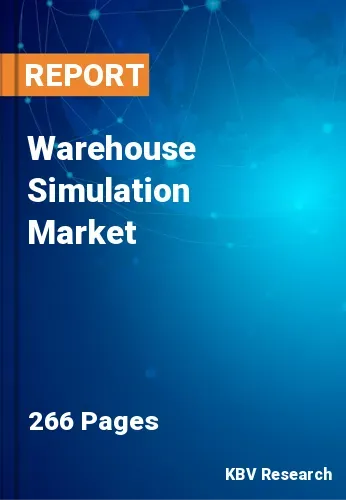
 Drivers
Drivers
 Restraints
Restraints
 Opportunities
Opportunities
 Challenges
Challenges
